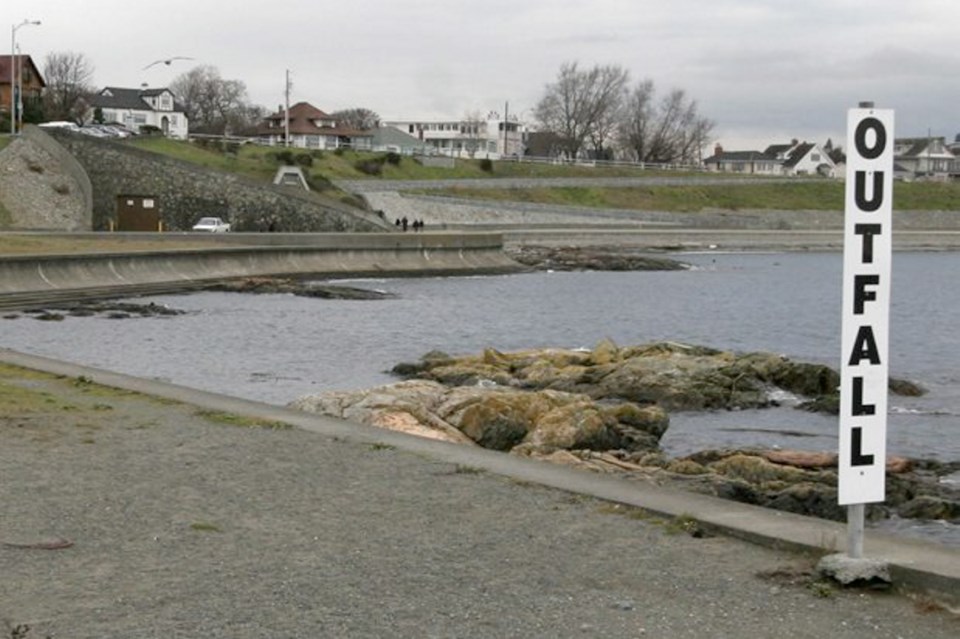Prohibitive costs for multiple sewage-treatment plants in the capital region will force a single-plant solution, even if that might not be appropriate, mayors say.
The Capital Regional District is about to go to the public for feedback on five options for sewage treatment: a secondary treatment plant at Victoria’s Rock Bay, a tertiary treatment plant at Rock Bay, or two, four, or seven plants around the region.
Preliminary cost estimates run between $1 billion and $1.3 billion, according to a report before Capital Regional District directors.
Esquimalt Mayor Barb Desjardins favours plants at multiple sites.
Smaller plants can be more innovative with wastewater recovery, more resilient and capable of dealing with growth, she said.
Having multiple plants would also make the region less vulnerable than it might be with a single plant if there’s an earthquake or other disaster, or major equipment failure.
But under the existing cost allocation formula, households in some municipalities would see huge jumps in annual fees if a multiple plant option is chosen.
In Colwood, for example, a two-plant option — with one in Colwood and the other at Victoria’s Rock Bay — would mean an annual household charge of $766, versus $252 for a single plant.
“What the cost-allocation formula right now does is drive us to a single site,” as opposed to looking at the advantages that come with having multiple sites, Desjardins said.
Under the existing formula, having a plant in Colwood means taxpayers there would have to bear a cost for facilities that benefit the entire region, she said.
The cost-allocation formula must be changed, perhaps to one based on sewage flow, per capita use, or cost versus benefit, Desjardins said.
After grants from provincial and federal governments are factored in, annual per-household sewage treatment fees have been projected at $427 in View Royal and $465 in Esquimalt if a single plant is built.
But for the seven-plant option, it would be $976 in View Royal and $1,023 in Esquimalt.
There’s also the issue of whether plants should provide secondary treatment, which removes dissolved organic solids, or tertiary, which further treats the water, removing pharmaceuticals, for example.
The resulting water can be used for things such as irrigation, industrial processes, or even drinking.
View Royal Mayor David Screech said in a single-plant scenario, his community might upgrade to tertiary ($509 per household) from secondary treatment ($427).
However, taxpayers aren’t likely to support a multi-site option if rough cost estimates are correct, he said.
“My gut reaction, I must say, is that clearly we are seeing again that one centralized plant is going to be the more cost-effective alternative, and that is going to be a hard discussion around the table,” Screech said.
“I don’t think our community would support [multiple] plants given the rough cost estimates that are there, I really don’t. They are staggering amounts. I think it’s possible they may well support the more expensive centralized option — tertiary treatment.”
Desjardins, Screech and Victoria Mayor Lisa Helps say when the last plan was costed in 2007, it was $1.2 billion and was whittled down to $788 million; they say that will be the case here, also.
“I think there is no doubt that a significant buffer is built in,” Screech said.
But former federal environment minister David Anderson said a treatment plant ringing in at $788 million has always been a “fictitious” figure.
“It’s time the CRD came clean. It’s showing itself to be dysfunctional when it comes to the largest construction project they’ve ever handled,” Anderson said.
He likens the costs of sewage treatment to the skyrocketing costs for replacing the Johnson Street Bridge in Victoria.
Political pressure and timeline pressure for funding are pushing bad decisions, he said.
Anderson is honourary chairman of the Association for Responsible and Environmentally Sustainable Sewage Treatment (ARREST), which has long argued that deep-water outfalls into the frigid, fast-moving Pacific Ocean act as a type of natural sewage treatment.
Anderson continues to call for a proper cost and benefit analysis to see whether sewage treatment is even needed in the region.
A 2004 study by the Society of Environmental Toxicology and Chemistry found sewage treatment may be necessary in the future, but said it wasn’t needed now.
“The CRD is meant to be responsible to the local taxpayer and this is not an urgent issue at all. It should be on the 2040 timetable at the earliest — not 2020,” Anderson said
In 2006, the provincial government mandated sewage treatment. In 2012, the federal government passed a law requiring all high-risk Canadian cities — including Victoria — to provide secondary sewage treatment by 2020.



